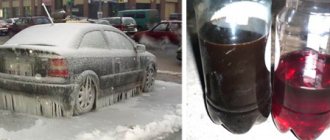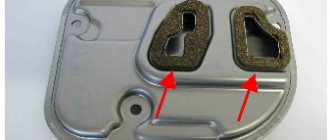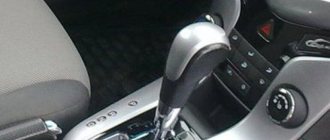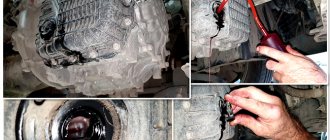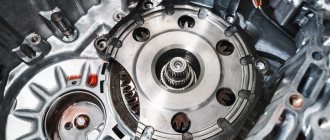As you know, an automatic transmission is a complex combination of hydraulics, mechanics and electronics. At the same time, hydromechanical automatic transmissions are characterized by increased requirements for the level, quality and condition of the transmission fluid. It should be added that this is more or less true of both “classic” automatic transmissions and CVTs, dual-clutch robots, etc.
In simple words, the liquid in the box must be clean, have suitable properties and be poured in sufficient quantity (no more and no less than the recommended level). In this case, the box will work correctly, wear of parts and elements will be minimal, which can significantly increase the service life of the unit.
At the same time, to maintain the purity of the ATF in the box, the fluid must be changed periodically. At the same time, the automatic transmission oil filter is also replaced. Also in some cases it is recommended to flush the automatic transmission. In this article we will look at why flushing an automatic transmission is needed, as well as how to flush an automatic transmission and how to do it.
Automatic transmission flushing: diesel fuel, flushing oil and other methods
As you know, an automatic transmission is a complex combination of hydraulics, mechanics and electronics. At the same time, hydromechanical automatic transmissions are characterized by increased requirements for the level, quality and condition of the transmission fluid. It should be added that this is more or less true of both “classic” automatic transmissions and CVTs, dual-clutch robots, etc.
At the same time, to maintain the purity of the ATF in the box, the fluid must be changed periodically. At the same time, the automatic transmission oil filter is also replaced. Also in some cases it is recommended to flush the automatic transmission. In this article we will look at why flushing an automatic transmission is needed, as well as how to flush an automatic transmission and how to do it.
Why do you need to flush an automatic transmission?
As mentioned above, an automatic transmission is a complex unit, and transmission oil plays a vital role in such a gearbox. First of all, ATF is a working fluid, since torque is transmitted through it in the torque converter.
ATP also actively circulates through the channels of the valve body, directly participating in the process of turning on the actuators, which allows the box to operate in automatic mode.
It is important to understand that during operation the oil gradually loses its properties and loses its washing ability. Also, contaminants and wear products, microparticles, etc. accumulate in the liquid. As a result, working with such oil leads not only to malfunctions, but also to wear of the box, the formation of scoring on surfaces, blockage of channels, etc.
Naturally, the oil pressure in the automatic transmission may drop, causing kicks, jerks and jolts of the automatic transmission. Gears can slip and slip; in some cases, the automatic transmission crashes (emergency mode is activated).
This is the main problem. Of course, the box can be disassembled, the valve body can be removed, the automatic transmission hydraulic plate can be washed and cleaned. The hardware replacement can then be performed using the preemptive method. It is not difficult to guess that such an approach will require significant costs and expenses (partial disassembly of the box and removal of the valve body, large total consumption of transmission fluid when replacing it on the device).
The only way that allows you to “delicately” clean an automatic transmission without disassembling it is to flush the automatic transmission. This method allows you to maintain the automatic transmission in working condition for a long time without repair, while the risk of breakdowns and premature repairs due to contamination of the unit is minimized.
Transmission Service
Many automakers declare their automatic transmissions as maintenance-free, which relieves car owners of the need for transmission service. However, during the operation of the car, wear products appear in the oil. The lubricant loses its properties and begins to coke.
The moving elements are poorly lubricated, they begin to wear out prematurely, and eventually the transmission completely fails. A timely replacement of the transmission oil and flushing the gearbox would help to avoid this. The latter is necessary in cases where low-quality oil was used, as well as when the vehicle runs more than 200-300 thousand kilometers.
In this way, the car owner solves problems with the operation of the automatic transmission, which reduces his costs and eliminates the need for expensive and complex repairs.
If you have difficulties with the operation of the transmission, you can contact a service station, whose technicians will tell you whether it is possible to flush the automatic transmission and, if necessary, will do it in a short time.
The valve body is a complex mechanism that includes a valve plate, a radiator, numerous oil channels, solenoids, and various actuators and measuring mechanisms. The operation of the entire gearbox depends on the performance of the valve body. It is this unit that bears an increased load, as a result of which, after 50-100 thousand kilometers, deposits and contaminants appear in numerous channels, valves and solenoids, which must be removed in a timely manner.
How to flush the automatic transmission yourself
So, it is recommended to completely flush the automatic transmission in cases where the ATP fluid was heavily contaminated, the oil in the box has not been changed for a long time, for preventive purposes, etc. At the same time, washing the automatic transmission with your own hands is a completely affordable procedure and can easily be done in a garage. Note that there are several available flushing methods, which are usually combined with changing the oil in the automatic transmission.
To accomplish this task, you will need to have 12-15 liters of ATF or Dexron fluid. It is not recommended to mix different liquids and products in order to save money. After the old oil has been drained, the oil filter has been replaced and the automatic transmission pan has been replaced, fresh oil is poured into the box.
Then a flushing device is connected to the automatic transmission cooling system (the pipes of the device are connected to the system in the places where the automatic transmission radiator is connected). After this, the engine is started, then the unit runs for 10-20 minutes.
The device remains connected to the cooling system. Next, you need to start the engine again and allow the previously filled oil to pass through the system for several circles. During flushing, you also need to turn on different automatic transmission modes so that the oil spreads through different channels and lines, cleaning all automatic transmission parts.
Once the liquid pumped out of the device becomes completely clean, and the amount of oil being poured is equal to the amount that flows out, the process can be considered complete. This method of flushing and changing the oil in an automatic transmission is usually called full-flow.
After the oil and additives have cleaned the unit, the flushing can be considered complete. Then the waste is drained, and it is important to remove as much oil as possible from the unit. Now all that remains is to fill the level with fresh oil. As you can see, this is a simpler method, since you do not need to fill and drain the fluid twice (first remove waste, then flush) and change the automatic transmission filters before and after flushing.
We also note that in some cases a special automatic transmission flushing oil containing special additives is also used. This solution is poured into the automatic transmission after draining the waste, then, at the end of the cleaning process, the flushing needs to be drained and fresh oil refilled, after first replacing the automatic transmission filter.
At the end, the mixture of ATP and kerosene is drained in as much as possible, then washed with regular oil. Next, this oil also needs to be drained, after which the automatic transmission filter is changed and fresh transmission fluid is added.
Replacing transmission fluid: a detailed description of the process
All work on changing transmission oil in an automatic transmission is done with your own hands in several stages.
Warming up the car. Before you take your car in for an oil change, you need to drive it a little so that the fluid in the units warms up. When heated, it becomes less viscous and its fluidity improves. After this, the car is turned off and put on the handbrake. Additionally, you can install wheel chocks.
Removing the crankcase protection. This is one of the easiest operations and is performed using a key. This must be done to gain access to the pallet.
Draining oil from automatic transmission. To do this, you need to place a container under the automatic transmission and unscrew the drain plug. Drain the liquid until it flows freely. To prevent it from spilling, you can use a special hose.
Removing the pallet. This operation is performed using a key. Don't forget that there is oil left at the bottom of the pan. When all the bolts are unscrewed, you will need to carefully pry up the pan with a screwdriver and remove it. Try not to damage the surface adjacent to the automatic transmission housing. If dents remain, the seal will not be tight and a leak may develop.
Replacing the machine filter and heat exchanger. The automatic transmission filter can be recognized by its black or silver color. It is attached with several bolts. Some filter elements are a fine mesh that can simply be washed with carburetor cleaner. But for your own peace of mind, it is better to change it to a new one. The heat exchanger is unscrewed, and the filter in it is also replaced with a new one.
Preparing the pallet for installation. The old gasket or sealant must be completely removed from the pan and from the automatic transmission housing. If there is a sealant instead of a gasket, then the application area must be treated with a degreaser. The sealant is applied in a continuous seam, going around the edges of the bolt holes. The gasket is installed clearly along the contour so that it does not protrude anywhere.
Pallet installation. When it is ready, you can put it in place. The bolts are tightened tightly and the drain plug is installed along with a new gasket.
Filling with oil. It is poured using a funnel through the filling tube. You can safely immediately fill in the same volume that was drained from the automatic transmission. After this, you should monitor the oil level using the dipstick. When the Cold mark is reached, filling should be stopped.
Warming up the unit. Now you need to start the car and let it run for 1-2 minutes. Using the automatic transmission selector you need to go through all its positions one by one. If the oil change is partial, then it is necessary to check the fluid level in the machine. It should be between the two Hot marks. If it is lower, then add the required amount of oil.
This completes the partial oil change in the automatic transmission. If you have planned a complete replacement, then after warming up the car you will need to turn it off and drain the fluid through the pan again and fill it with fresh one. If the transmission being drained is dirty, the operation should be repeated until it becomes light. When this is achieved, you can repeat step 9 as a final step.
It should be remembered that the transmission fluid level must not be lower or higher than the specified level. If this rule is not followed, air will circulate through the box. Bubbles oxidize the oil and parts, which leads to their premature aging. And overfilling is even more dangerous because it creates excessive pressure in the automatic transmission, which will cause oil to be released and lost.
What's the result?
As you can see, in addition to hardware replacement and the displacement method, there are also special flushing additives for automatic transmissions or flushing oils for automatic transmissions. Some owners also use kerosene or gasoline.
Automatic transmission repair and maintenance specialists recommend cleaning with special means only in case of urgent need, that is, avoiding additives or cleaning compounds. In other words, it is best to clean the automatic transmission with transmission oil, which is completely suitable in properties for a particular automatic transmission.
To avoid contamination of the box, it is better to change the oil in a timely manner, and also make allowances for operating conditions (the replacement is made earlier than required by regulations). This approach allows us to eliminate the risks that arise after using automatic transmission flushing oils, cleaning additives for waste, and, especially, kerosene, gasoline or diesel fuel.
How to wash the automatic transmission valve body yourself: removing, disassembling, cleaning the automatic transmission valve body. What to consider when washing, useful tips and recommendations.
How to determine that the automatic transmission is overheating: signs indicating overheating of the automatic transmission. How to improve automatic transmission cooling and prevent the machine from overheating.
How to change the oil in an automatic transmission: available methods for replacing ATF in an automatic transmission, the pros and cons of each method. What is the best way to change transmission oil in an automatic transmission.
Getting ready for an oil change
How can I clean the injectors without removing them from the engine?
So, every responsible car owner sooner or later asks a seemingly simple, but in practice requiring help, question “How to change the oil in an automatic transmission yourself?” After all, over the many years of car development, we seem to have figured out everything about changing the engine oil, but another unit - the automatic transmission - is still shrouded in mystery for many.
how to fill oil in automatic transmission
It's okay, because if you have some experience working with a wrench and a sledgehammer, it is quite possible to change the oil in an automatic transmission yourself, and now we will even explain to you what and why, how to drain the oil from an automatic transmission and, accordingly, how to pour this oil into the automatic transmission . And, of course, what difficulties we will have to face along the way during these operations.
The first obstacle for you will be the fact that the transmission is obviously located at the bottom of the car - either in the engine compartment next to the engine in front-wheel drive cars, which is what the majority are now, or the automatic transmission is located behind the engine, in the area of the central tunnel in rear-wheel drive and all-wheel drive cars.
How to wash an automatic transmission yourself at home
Flushing the automatic transmission is a mandatory procedure that the car owner does after a long run of the car. It not only helps to remove dirty deposits on the valve body valves, and destroy excess dirt from the turbine and torque converter pump wheel. Flushing increases the service life of the automatic transmission. Each flushing of the gearbox makes its operation more stable over several tens of thousands of kilometers.
Why do you need to flush an automatic transmission?
The automatic transmission flushing procedure is important because during operation, the lubricant loses its cleaning properties. The oil gradually accumulates wear products from mechanical parts, spreading them throughout the gearbox.
At an operating temperature of 70 - 80 degrees Celsius, these products melt, and then, as the machine cools, they settle in the places where they last stopped. Thus, carbon deposits are formed.
The above reasons lead to a drop in pressure inside the automatic transmission, jerking and kicking. The machine may fall into emergency mode and the car will not move.
Attention! Many car enthusiasts will say that flushing is the same as a complete replacement of the transmission fluid and there is no need to disassemble the automatic transmission once again. Experts say that no matter how completely the lubricant is changed, some of the oil with wear products remains in the deep corners of the automatic transmission and is not washed out during any replacement.
Therefore, washing the automatic transmission should be carried out regularly with each preventive maintenance.
How often do you need to flush the automatic transmission?
Experts advise flushing the automatic transmission in the following cases:
Flushing the automatic transmission during a complete oil change at home also helps to check for faulty components. For example, if the automatic transmission continues to kick or jerk during acceleration after flushing and filling with fresh transmission fluid, then the problem is in the mechanical components of the transmission or the electronic control unit. In this case, the car should be taken to a service center.
What you need to prepare for washing the automatic transmission
Automatic transmission washing, even at home, should be carried out at a professional level. This means that you need to prepare all the tools and materials so that you don’t have to run around looking for them later.
To flush the automatic transmission you will need the following materials and tools:
All these tools must be prepared and left in the garage or the place where self-disassembly and washing will take place. After this, you need to get behind the wheel to begin the procedure.
Attention! Vehicle service centers use special washing units with high-pressure units. Therefore, the car owner decides to wash the machine himself or use the services of a service station.
How to flush the automatic transmission yourself
If the car owner does not know how to flush the automatic transmission on his own, then the following instructions will help him with this.
The usual procedure is carried out by draining the used oil and adding new oil, starting the engine and repeating the process using the displacement method. This method is used when completely replacing the lubricant. In this case, the box is not dismantled.
You can wash the box this way by following the steps below:
This will complete the cleaning step. The old oil was replaced by new oil. Car owners believe that this is enough to flush the automatic transmission. Some people use cleaning additives in this case, although experts do not recommend it. Since their effectiveness has not been proven, various impurities can harm the automatic transmission.
Attention! Use original oil from the manufacturer. Experts recommend replacing with analogues that match the properties if the original is not available. But never fill in cheap fakes. This will kill the automatic transmission.
Pallet
It happens that a layer of dirt accumulates in the automatic transmission crankcase, which cannot be washed without removal. It is secured differently on different cars, but the principle is the same - unscrew the bolts along the contour. You can clean it with whatever you have at hand - gasoline, carburetor cleaning fluid and even dimexide (this is where it is safe to use). The liquid is simply poured into the crankcase, given time for the dirt to dissolve and drained. Wipe dry with a rag and put the tray in place.
Do-it-yourself crankcase cleaning
Often car owners, when washing the box themselves, use gasoline. But if the contamination is severe (and it happens that almost black oil drains from the crankcase), gasoline does not help. You can try a product from household stores - Shumanit. The product corrodes any contaminants. You can also use diesel fuel, kerosene, five-minute flush and other similar liquids as a liquid.
The meaning of cleaning
During the operation of the automatic transmission, part of the production settles on the oil filter and other mechanisms of the car. With an increase in dirt on the parts, the operation of the automatic transmission is disrupted, which leads to disruption of the entire device and affects the comfort of its use.
All automatic transmissions are equipped with a special oil filter. It is necessary to clean the oil and extend the life of the machine.
Over time, the automatic transmission fluid becomes contaminated with various types of metal dust and other friction products. When they begin to exceed the permissible limit, the throughput of the automatic transmission becomes less.
This causes the oil to heat up, causing even more debris to accumulate. As a result, the rubber bands break and it just stops.
Cleaning is necessary to remove all dirt and prevent problems with the box.
If you do not change the oil and clean the automatic transmission in a timely manner, the following problems may arise:
As a rule, when problems arise with an automatic transmission, the vehicle loses one or more gears, and problems with their shifting are also possible.
If the problem is with the internal parts of the transmission, you will need to flush it yourself or seek help from a professional mechanic who specializes in transmission repair.
Symptoms of valve body malfunction
Symptoms
A characteristic sign of a faulty automatic transmission valve body is increased vibrations and grinding noises when changing gears. In some cases, a complete stop of the engine may occur when the selector is moved from Parking mode to Drive mode. Also, quite often the malfunction manifests itself in shocks, impacts and slipping between gears. Modern cars, equipped with numerous sensors, when they break down, display a message indicating that the gearbox is damaged. The exact cause of the breakdown can only be determined by connecting the computer to diagnostic equipment and carrying out the appropriate gearbox tests. In this case, you can install the failed element. However, it is impossible to say exactly the nature of the breakdown even after computer diagnostics. It is necessary to dismantle the hydraulic unit and disassemble it.
Photo of automatic transmission valve body
Self-repair - is it possible?
The valve body can be repaired in specialized workshops and service centers. Do-it-yourself automatic transmission valve body repair is only possible if you have practical experience working with such spare parts. You will need to dismantle (in some cases) the automatic transmission, open the housing and first check the valves. You most likely will not be able to clean them yourself, because... Professional equipment is used for this. Also be sure to check the valve body springs, which tend to wear out. Reassembling the valve body structure is of great importance, if you make a mistake - the consequences can be much worse than replacing just one assembly part. As you can see, repair work can only be carried out by an experienced specialist if he has the appropriate equipment.
Valve block diagram
The cost of repairing a hydraulic unit directly depends on the nature of the breakdown. For example, problems with springs, valves, and solenoid blocks are quite often noted. Many car service centers do not undertake repairs, citing the fact that it will be cheaper to replace it when assembled. This is not always the case, you can contact us and we will be happy to repair the valve body inexpensively and efficiently. Due to the fact that the design of the valve body is quite complex, consisting of a large number of parts, it requires a huge amount of knowledge and experience to carry out such repairs. The cost of such repairs can range from 10,000 rubles to several tens of thousands of rubles. There is also the problem of a clogged valve body, when the valve plate spools begin to stick. In some cases, it makes sense to replace a broken element rather than try to carry out an expensive and complex restoration procedure.
Automatic transmission valve body repair - Video
As a preventive measure to prevent hydraulic unit breakdowns, we recommend that you closely monitor the condition of the automatic transmission cooling system. It is the incorrect operation of the cooling system that is one of the most common causes of damage to this element.
Valve block repair - price in our service
Also, the car owner should properly operate his car and the automatic transmission in particular. Especially in winter, you should not start driving the car without first warming up the oil in the gearbox. This procedure takes only a few minutes and allows you to easily bring the oil temperature in the gearbox and valve body to the required temperature. This way you can ensure high-quality cooling and lubrication of moving elements.
To warm up the transmission, you need to move the selector to the Drive (D) position and hold the brake for one minute. Immediately after this you can start moving. You should also remember that after starting to drive in a cold car, it is not recommended to spin the engine above 3000 rpm. By following these simple rules, you can protect the gearbox and valve body from damage and extend the trouble-free life of your car.
First way
Consult an auto parts professional to ensure you purchase the correct oil.
After draining the waste, it is necessary to replace it with a new one and wash the box. It is better to carry out rinsing in the pit, because you will have to unscrew the pan to remove any remaining liquid.
The manipulation process:
Open the hood and locate your dipstick. Typically the oil level indicator is red while the engine oil level indicator is yellow. Add transmission fluid slowly, checking the level regularly to avoid overfilling.
Mild Cleaning Oil Additives
To flush the MS, additives have also been developed with the effect of mildly cleaning the oil; they, like “regular five-minute additives,” are added to the crankcase. But their difference is that during such a wash the car must travel a certain distance, and only after that the oil is changed. Here the procedure is as follows:
- on a warm engine, remove the cap of the m/s neck, pour the contents of the bottle into the MS (standard capacity - from 300 to 450 ml);
- we drive 150-200 km by car;
- drain the waste, install the MF and fill in new oil.
Standard packaging is usually designed for an oil system with a volume of 4-5 liters; if the engine is heavily contaminated, it is not recommended to use such an additive.
Fourth method
The cleaning agent can be replaced with aviation kerosene. If there is such a product, you do not need any oil to clean the automatic transmission.
Changing the oil with flushing comes down to the following:
Many motorists do not recommend buying modern flushing oils.
According to numerous reviews, when using aviation kerosene, metal shavings and dirt will accumulate in the automatic transmission more slowly.
Cleaning chemicals work worse and you will have to change the oil more often.
conclusions
Carrying out the procedure every time you change the lubricant will avoid serious contamination and increase the service life of the unit. There are two ways to wash the automatic transmission yourself. The method is selected by the motorist himself separately for each case. The assembly and disassembly technology differs depending on the car model.
Do not use aggressive substances for cleaning. They can damage seals, gaskets and components. By following the sequence of actions, you will be able to clean the valve body channels yourself.
Have you washed the automatic transmission yourself without specialized equipment? Which method did you use for your car?
We save the automatic transmission with our own hands - changing the oil with running in the video:
Source
Advanced cleaning
For more complicated cleaning, you will need to remove the automatic transmission. At the same time, you can repair some parts if necessary.
A more complex flushing method is suitable if the procedure was already carried out a week or two ago, but problems with the automatic transmission have arisen again. In this case, it is necessary to remove the gearbox to see what is causing its poor performance.
It is necessary to break in the automatic transmission within 4–7 days. If you have problems with its operation again, it is better to contact a professional technician.
Perhaps during the disassembly process some part was not replaced or the automatic transmission was not washed properly.
HG7015/HG7019 Hi-Gear TRANS PLUS with ER SEALANT AND TUNING Hi-Gear FOR AUTOMATIC TRANSMISSIONS (contains “Friction Winner” ER) Prevents overheating and damage to automatic transmissions due to disc slippage. Eliminates jerks, skips or delays when shifting gears. Restores the elasticity and size of oil seals and gaskets, protects them from drying out and cracking. Eliminates leaks through seals and gaskets within 15 km. Cleans bypass valves and restores their functionality. Reduces wear and noise of automatic transmission. Compatible with all types of mineral and synthetic fluids for automatic transmissions of any design, including front-wheel drive vehicles. Suitable for any hydraulic systems. Safe for metal, plastic and rubber parts of all types of automatic transmissions. The presence of ER provides a significant increase in the cleaning, anti-wear and anti-noise properties of TRANS PLUS, which generally improves transmission performance and prevents oxidation of transmission fluid. Pack. 444 ml / 887 ml
(function(w, d, n, s, t) ); >); t = d.getElementsByTagName("script"); s = d.createElement("script"); s.type = "text/javascript"; s.src = "//an.yandex.ru/system/context.js"; s.async = true; t.parentNode.insertBefore(s, t); >)(this, this.document, "yandexContextAsyncCallbacks");



